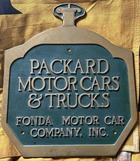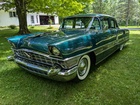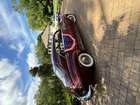|
Login
FAQ's
Main Menu
Recent Forum Topics
Who is Online
97 user(s) are online ( 1 user(s) are browsing Packard Decoder)
Members: 1
Guests: 96
su8overdrive,
more...
Helping out...
PackardInfo is a free resource for Packard Owners that is completely supported by user donations. If you can help out, that would be great!

Video Content
Visit PackardInfo.com YouTube Playlist

|
Introduction to the Packard Decoder
|
|
The Packard Decoder will hopefully over time be able to Decode nearly any Packard Vehicle Number or Packard Engine Serial Number. If you are unfamiiar with the various numbers that are on Packards, please take a moment to read the information below. It will provide you an overview of what the different numbers are, and where they are located. Once you've located either a Vehicle Number or Engine Serial Number, you can use the search boxes above to decode it.
|
|
Vehicle Number (VN)
|
|
The Vehicle Number (VN), also know as the Patent Plate Number or Serial Number, and sometimes incorrectly by the modern nomenclature Vehicle Identification Number (VIN). The VN is a Packard generated number and was used on every Packard since the very beginning. This number was located on a metal plate referred to as the Patent Plate. This plate may also include the delivery date, dealer, and trim codes. This information varies based upon the year/series.
|
| • | Some early models attached the Patent Plate to the inside of the firewall near the brake/clutch pedals. |
| • | 1937 and prior models had the Patent Plate attached to the engine side of the firewall/cowl. |
| • | 1938 models did not use a metal plate, but rather a sticker that resembled a Patent Plate. These are often missing/degraded. |
| • | 1939 - 1950 models had the Patent Plate attached to the engine side of the firewall/cowl. |
| • | 1951 - 1953 models had the Patent Plate attached to the driver's side 'A-pillar' door jam. |
| • | 1954 – 1956 models did not have a Patent Plate, but a much smaller embossed stainless plate. This was attached to the driver's side 'A-pillar' door jam. |
|
The Vehicle Number typically uses the following format:
|
|
(#)###-####(#)
|
|
( Body Model Number – Sequential Production Number )
|
|
Examples: 553-1234 and 5492-12345
|
|
Beginning with the 1947 21th Series, the first two digits are the Packard Series Number (21 = 21st Series, 54 = 54th Series) and when combined with 3rd and 4th digit make up the body model number (2182 = 1947/21st Series - Clipper Six Touring Sedan) or (5492 = 1954/54th Series - Clipper Deluxe Touring Sedan). The last 4 or 5 digits represent the Packard Sequential Production number for that specific model. The numbers did not start from 1, some years it started at 11, some years 1001, and some years at 2001. If the VN was 5492-2001, it would have been the first Clipper Deluxe Touring Sedan of the 54th series.
Prior to the 1947 21st Series, cars were generally refered to by their (Chassis) Model number vs their Body Model Number. So in the 9th series, someone may say they have a 900, but that is a Chassis Model Number, so they could have one of four different Body Model Numbers (553, 558, 559, 563). The Vehicle Number will always reflect the Body Model Number as opposed to the Chassis Model Number. Also, prior to the 1947 cars, the Model Body Numbers do not start with the Series number, but the Chassis numbers do. Yes, I know, it's a bit confusing, but, if you type in your Vehicle Number above, it will hopefully sort everything out for you.
|
|
There are a couple exceptions and notes to the above format:
|
| • | Models prior to 9th Series used the engine serial number as the vehicle number. |
| • | 1949 22nd Series model use a 22##-9-#### format to differentiate them from the 22##-#### format of the 1948 22nd Series models. Also in some cases unsold 1948 22nd Series models had their original Patent Plates removed and replaced with a 22##-9-#### formatted plates so they could be sold as 1949 22nd Series models. |
| • | 1950 23rd Series model use a 23##-5-#### format to differentiate them from the 23##-#### format of the 1949 23rd Series models. Also in some cases unsold 1949 23rd Series models had their original Patent Plates removed and replaced with a 23##-9-#### formatted plates so they could be sold as 1950 23rd Series models. |
| • | 1955 and 1956 follow the standard format, but the engine number also matches the vehicle number. There are some cases were replacement engines were installed where this will not match. |
| • | Canadian built, Custom Bodied, and Export vehicles may differ from the standard format, and are beyond the scope of this information. |
|
Special Notes:
|
| • | In the Packard font, a capital I is acutally a 1. So for any Serial Numbers, treat any I as 1. |
| • | Before the standardization of VIN numbers, some DMV would use different numbers as the offical number for Title and other paperwork, if your paperwork does not match the Vehicle Number, then compare it to the Theft Proof Number, Engine Serial Number and Briggs Body Number, as they may have used that information instead. Also, some state may assign a their own serial number when information on a vehicle is lost, missing, or ambiguous. This is a modern (post Packard demise) number and has no tie back to anything that Packard created. As such, it is out of scope for the Decoder. |
| • | As metioned above, some folks still refer to their Packards by their (Chassis) Model Number instead of the more specific Body Model Number. While correct, it's not always specifc enough for the process of ordering parts or relaying exactly what you have. For example, if I said I have a 5401, that only narrows it down to a 1954 (54th Series) Clipper Deluxe model, but not the actual Body Style. If I said I had a 5492, that says specifically that I have a 1954 (54th Series) Clipper Deluxe Touring Sedan. If I was ordering mechanical parts, then only using 5401 (chassis model) is fine, as all the mechincal parts (drivetrain, brakes, etc) should all be the same. But what would be different based on the body style would be items like interior/exterior trim, glass, etc as that can be specific the body style. |
|
Examples of VN Plates
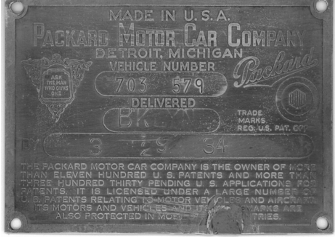
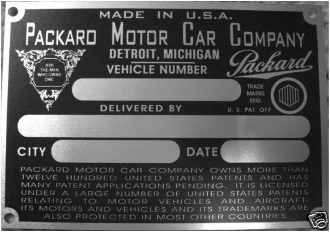

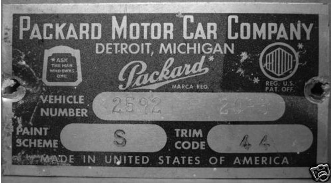

|
Briggs Body Number
|
|
The Briggs Body Number is located on a small stamped metal plated located on the engine side cowl/firewall on 1941-1954 Packards. During these years the bodies were built by Briggs Manufacturing for Packard. During construction Briggs attached the Body Number plate to the vehicle. The Briggs Body Number has been used by some DMV's as the vehicle number instead of the normal Packard vehicle number. So in the event paperwork does not match the Vehicle Number check the Briggs Number.
|
|
The Briggs Body Number typically uses the following format:
|
|
####-####(#)
|
|
( Model Number – Briggs Sequential Production Number )
|
|
Examples: 5492-1234 and 5492-12345
|
|
While this format is exactly the same as the Vehicle Number, the Briggs Sequential Production number may or may not match the Packard Sequential Production number, and cannot be assumed to be the same other that the first four digits. Most of the time the two production are very close together. The Briggs Body Number did not follow the ####-#-#### variant used in 1949 and 1950. It maintained the standard ####-#### format. Much like the Vehicle Number, the Briggs Body numbers did not start from 1, some years it started at 11, some years 1001, and some years at 2001.
|
|
Briggs Number Example
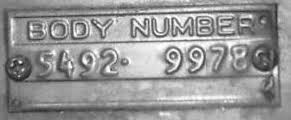
|
Theft Proof Number
|
|
The Theft Proof Number is a large raised number stamped directly into the engine side cowl/firewall starting in 1929 with the 6th Series models. This was added to Packards to provide a tamper resistant number that could be used to identify the vehicle in the event it was stolen and all other identifying markings were removed. Unfortunately, the records that link this unique number to its specific year, series, model and sequential production number were destroyed when Packard went out of business. The numbers can be uses to identify the year down within a year of two based upon compiled lists of known numbers, but have no direct pattern to anything else. This number has been used by some DMV's as the vehicle number instead of the normal Packard vehicle number. So in the event paperwork does not match the Vehicle Number check the Theft Proof Number.
|
|
The Theft Proof Number typically following the following format:
|
|
<X#####>
|
|
Examples: <A235I8> and <C22456>
|
|
A couple of comments and exceptions:
|
| • | The < and > represent raised stamped triangles that surround the number. |
| • | 1936-37 Juniors (120s, 115s, 110s) do not have the triangles surrounding the numbers. |
| • | A few 1940 vehicles have been reported to have no Theft Proof number. |
| • | Canadian built, Custom Bodied, and Export vehicles may differ from the standard format, and are beyond the scope of this information. |
|
Thief Proof Example
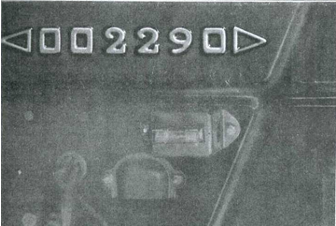
|
Engine Serial Number
|
|
The Engine Serial Number is a specific unique number assigned to search engine. This number is usually found on the main engine block in various locations depending upon the year/series. There are often casting or part numbers on the the various engine components (head, block, manifold, etc) that people confuse for the serial number. The engine serial number has been used by some DMV's as the vehicle number instead of the normal Packard vehicle number. So in the event paperwork does not match the Vehicle Number check the engine number.
| |
1955-1955 V8 Engine
|
| The 1955-1956 V8 Engine were pretty much the only engine where the serial number can be tied back to a specific car without any other supporting documentation. This is because the serial number should match the Vehicle Number (VN). Engine production number is usually stamped on pad at the rear of engine, visible from below. There are reports of later engines having this number at the from of the engine in the same general area as the vehicle number.
|
|
The 1955-1956 Engine Serial Number typically uses the following format:
|
|
####-####
|
|
( Model Number – Sequential Production Number )
|
Examples: 5562-1234 and 5662-1234
|
|
Serial Number Locations |
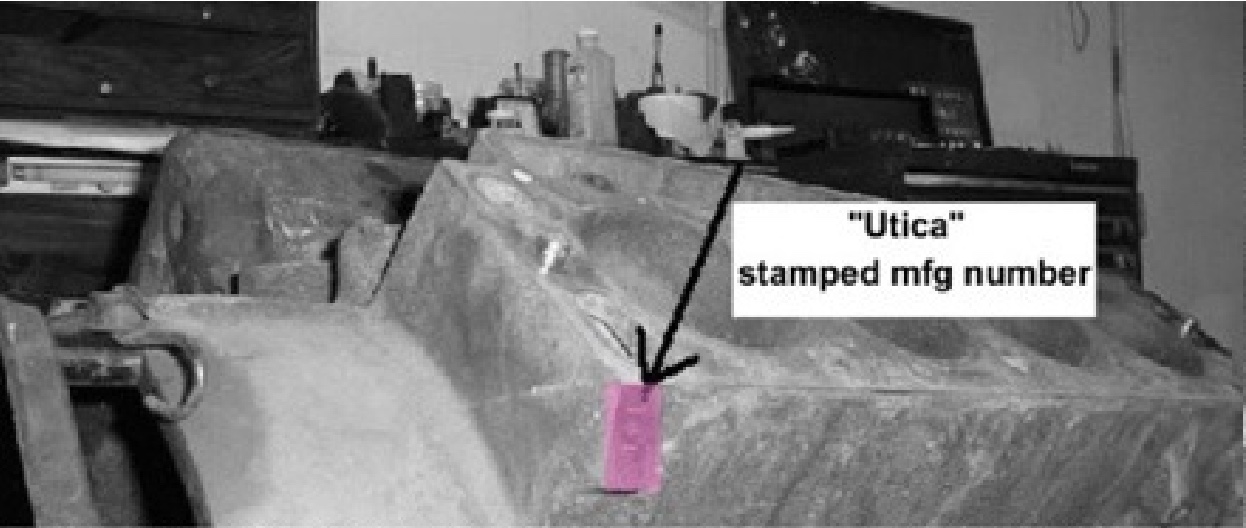 |
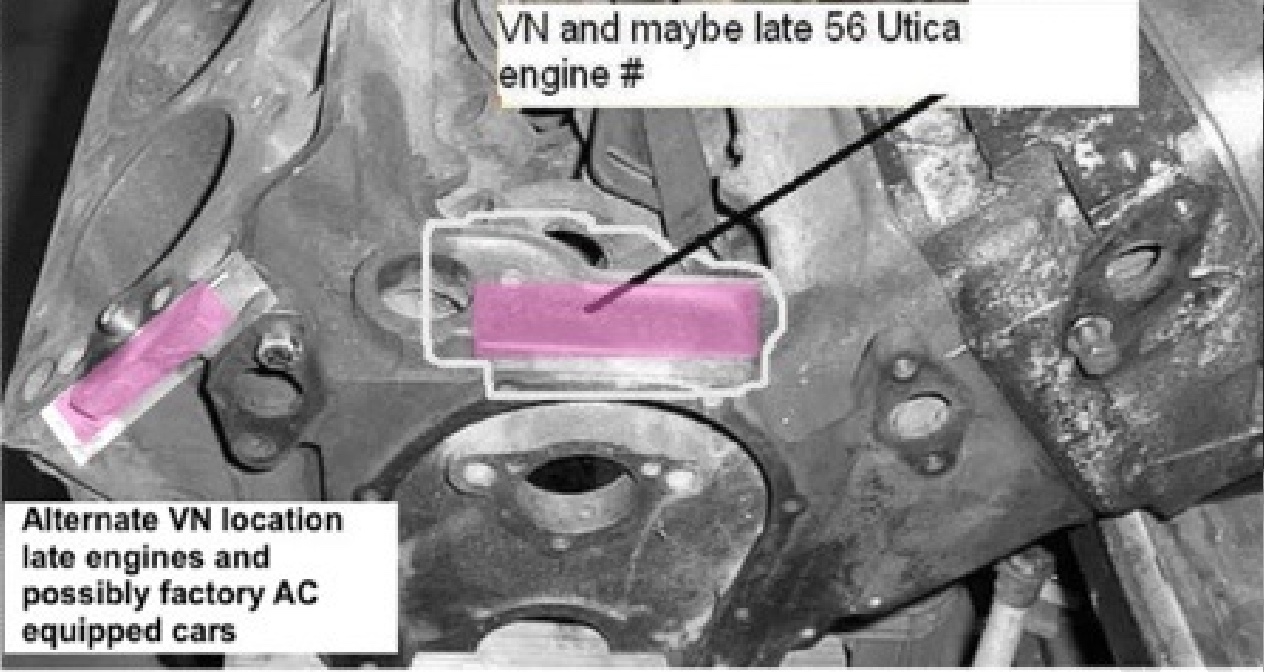 |
|
|
1951-1954 S8 Engine
|
|
The engine number is found on a machined pad on the engine block towards the back of the engine on the driver's side. It's just under the head and situated above the starter.
|
|
The 1951-1954 Engine Serial Number typically uses the following format:
|
|
X######
|
|
( X indicates Series, First # is Motor Type, Last five #s are the Sequential Production Number)
|
Examples: M202019 and K605000
|
|
Serial Number Location |
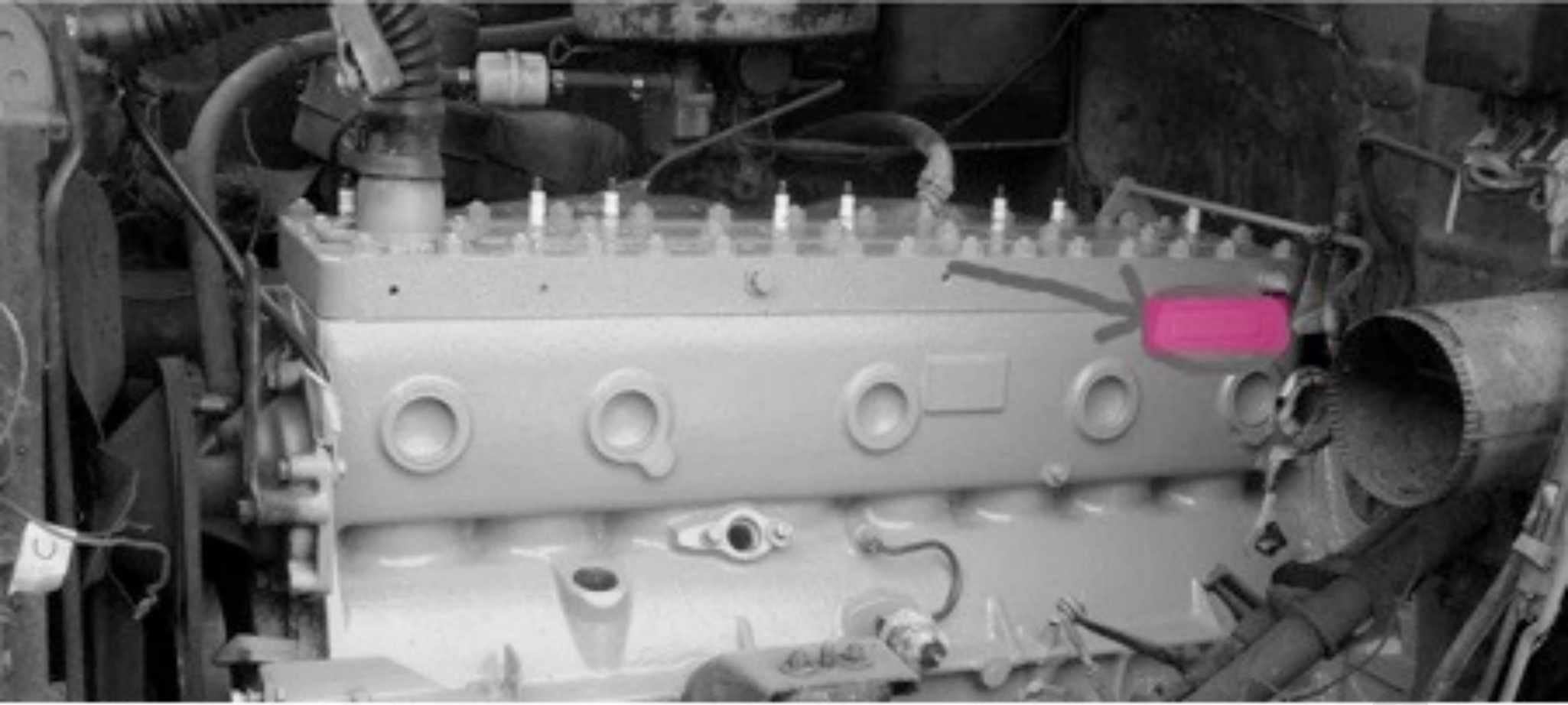 |
|
1937-1950 S8 and S6 Engines
|
|
The engine number is found stamped on a machined pad on the driver's side of the engine block, right below the head, either at the front or above the distributor depending the year and model.
|
|
The 1938-1950 Engine Serial Number typically uses the following format:
|
|
X####(##)
|
|
( X indicates Series, First # is Motor Type, Last three to five #s are the Sequential Production Number)
|
Examples: A1501 and G605000
|
|
Serial Number Locations |
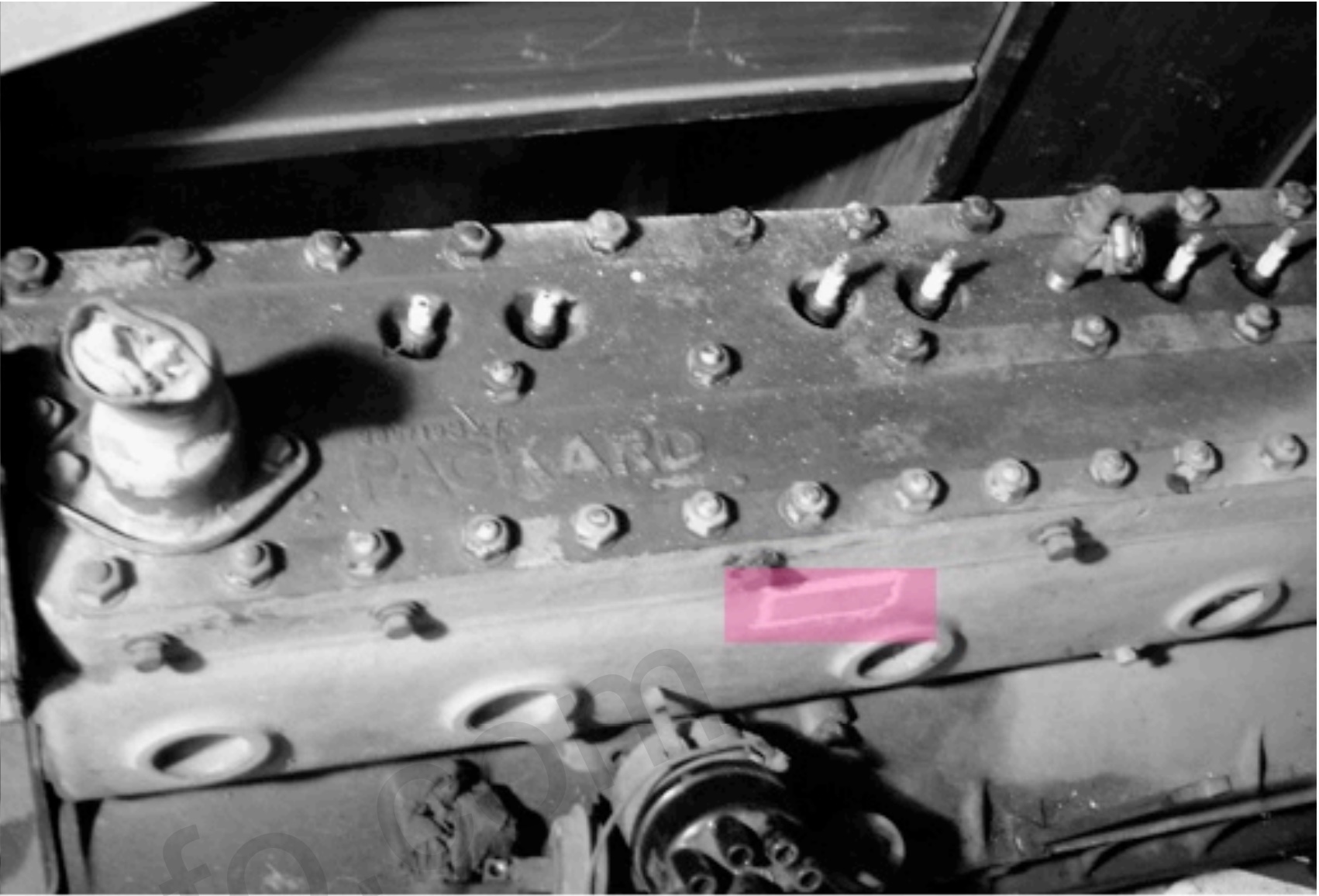 |
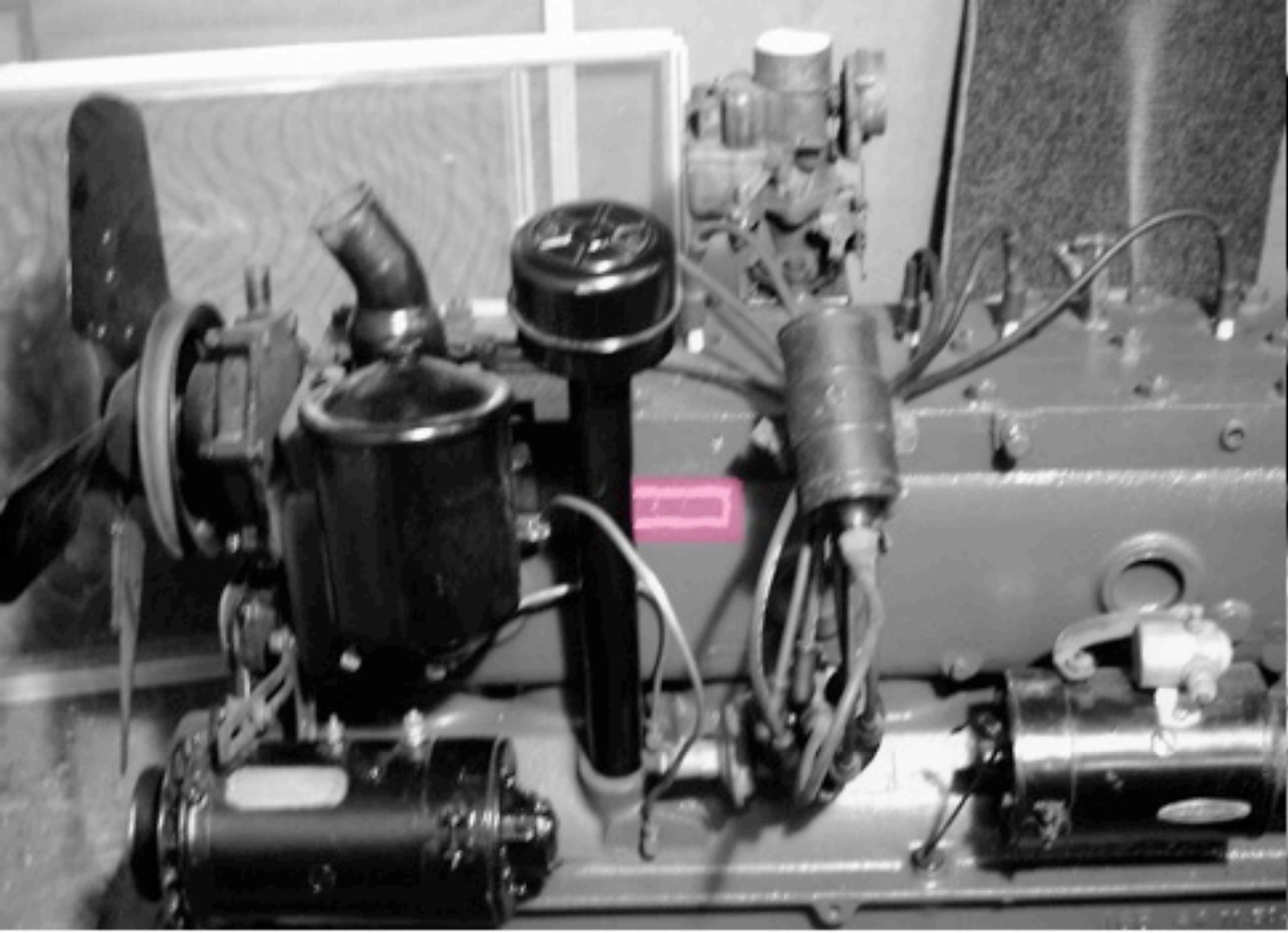 |
|
1937-1935 120 and 115 Engines
|
|
The engine number is found stamped on a machined pad on the driver's side of the engine block, near the base of the oil filler tube.
|
|
The 1938-1935 120 (8 CYL) and 115 (6 CYL) Engine Serial Numbers typically uses the following format:
|
|
X####(##)
|
|
( X = 120, T = 115, #s are the Sequential Production Number)
|
Examples: T1500 and X100001
|
|
Serial Number Location |
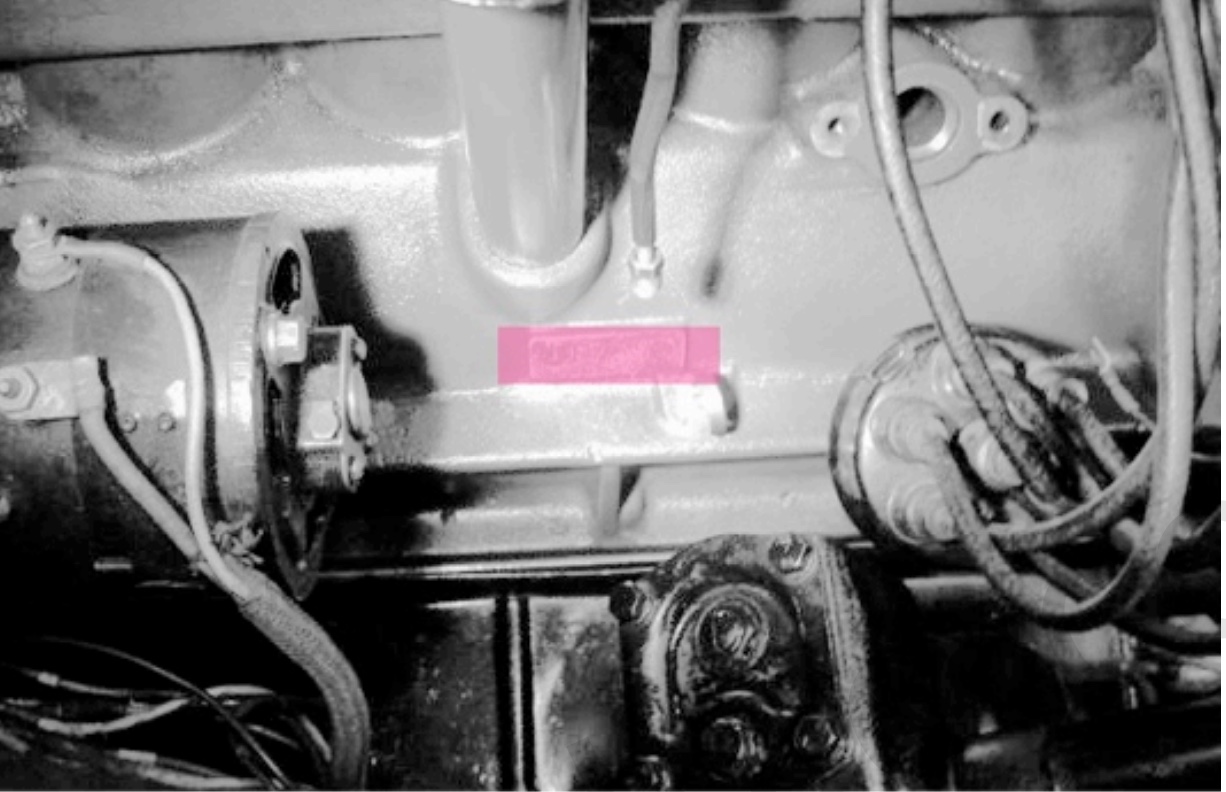 |
|
1937 and prior (except 120/115)
|
|
The engine number is found is a variety of differnt locations depending on year and enigne type. See pictures for more information.
|
|
The 1937 and prior (except 120/115) Engine Serial Numbers typically uses the following format:
|
|
####(###)
|
|
( Sequential Production Number )
|
Examples: 37000 and 208428
|
|
1934-1939 320cid and 385cid |
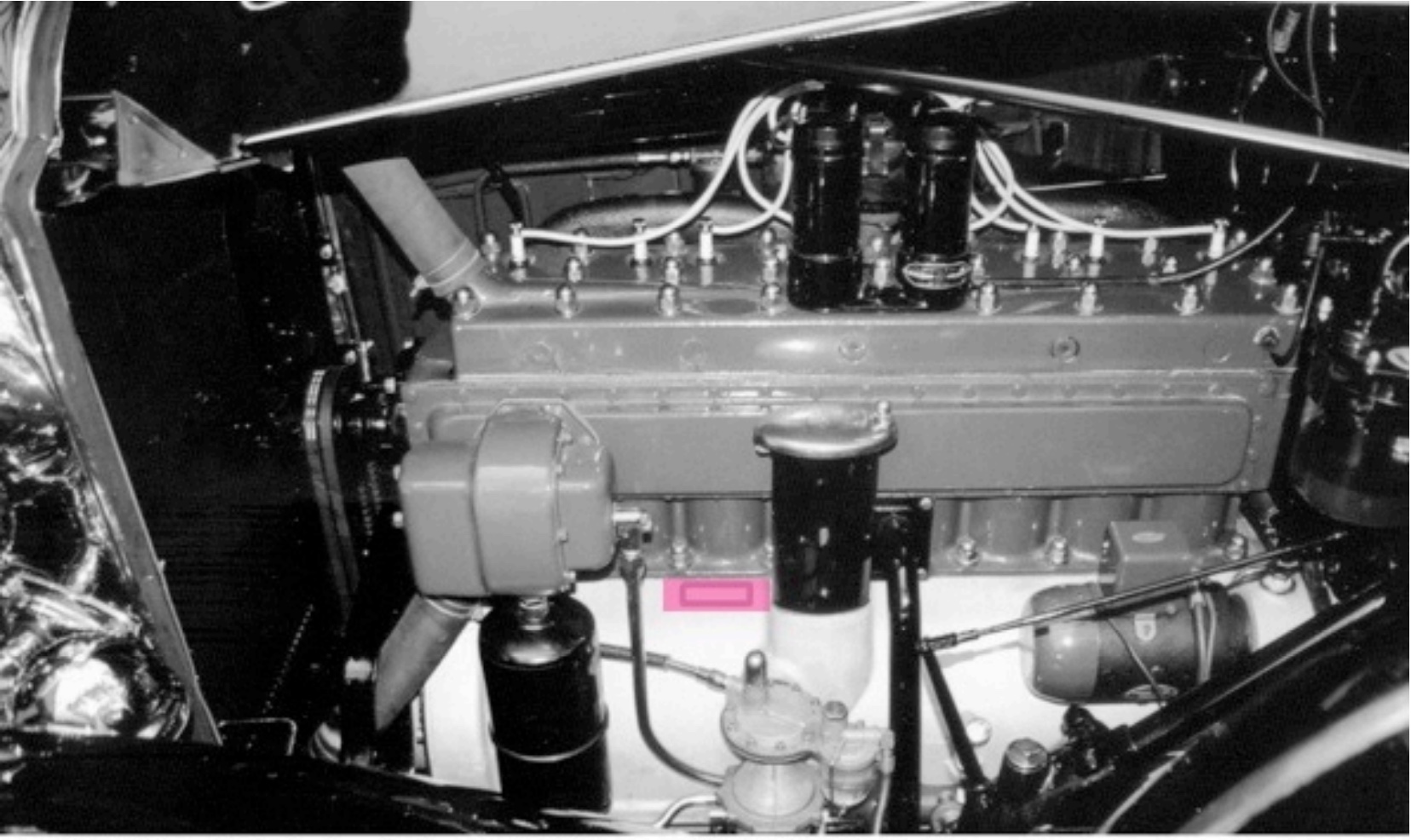 |
1933-1939 Twelve |
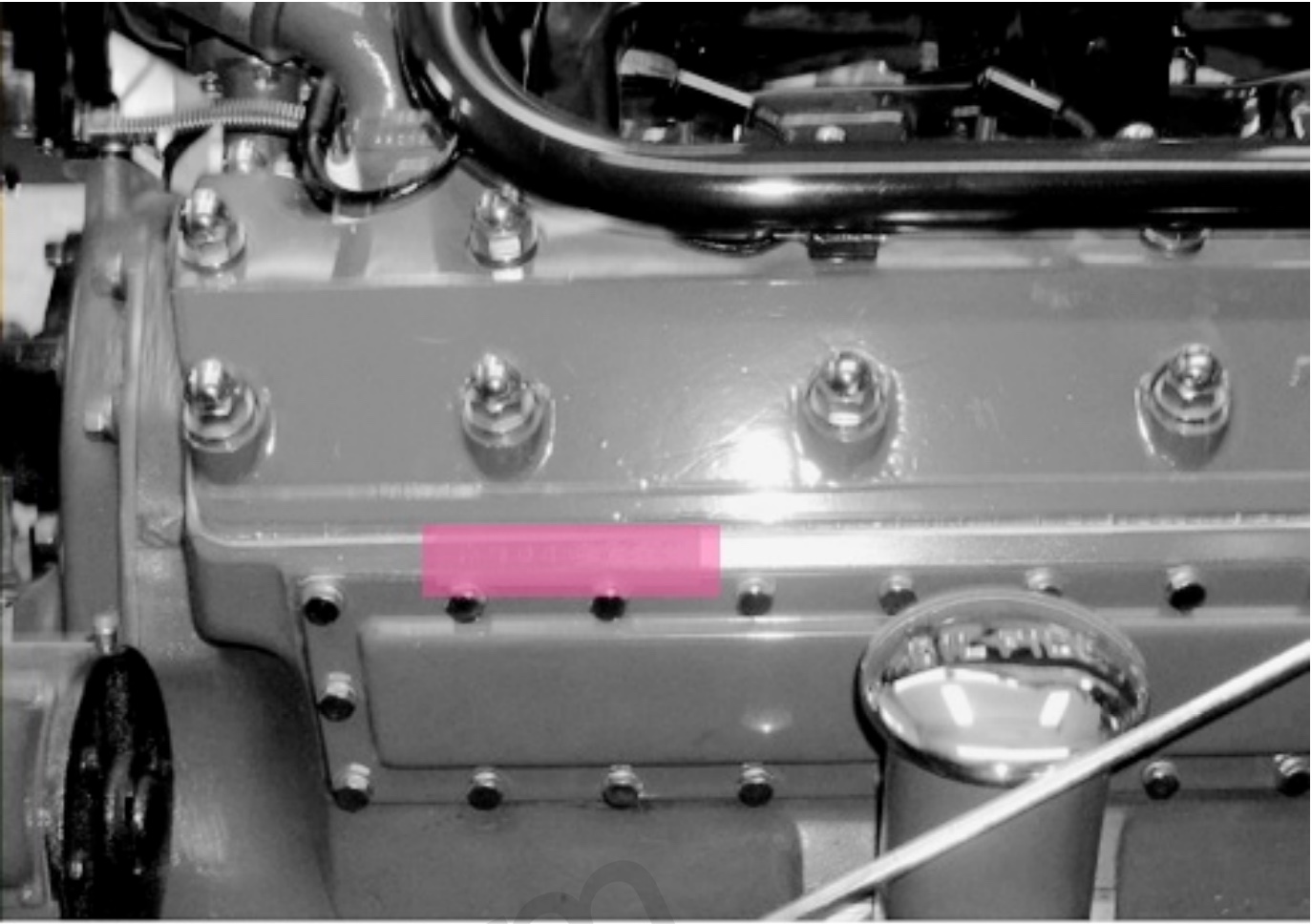 |
1929-1934 319cid |
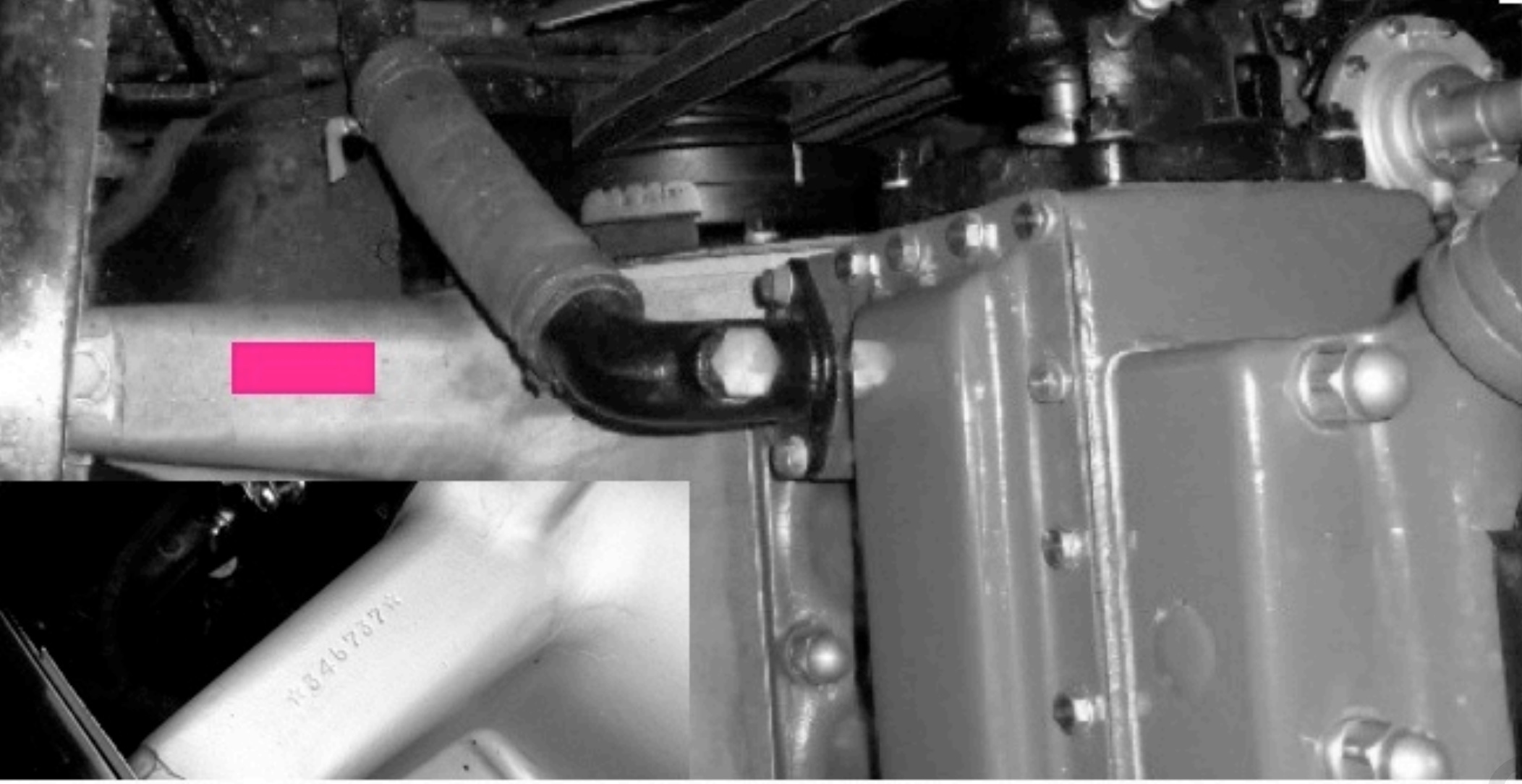 |
1920-1923 Single Six |
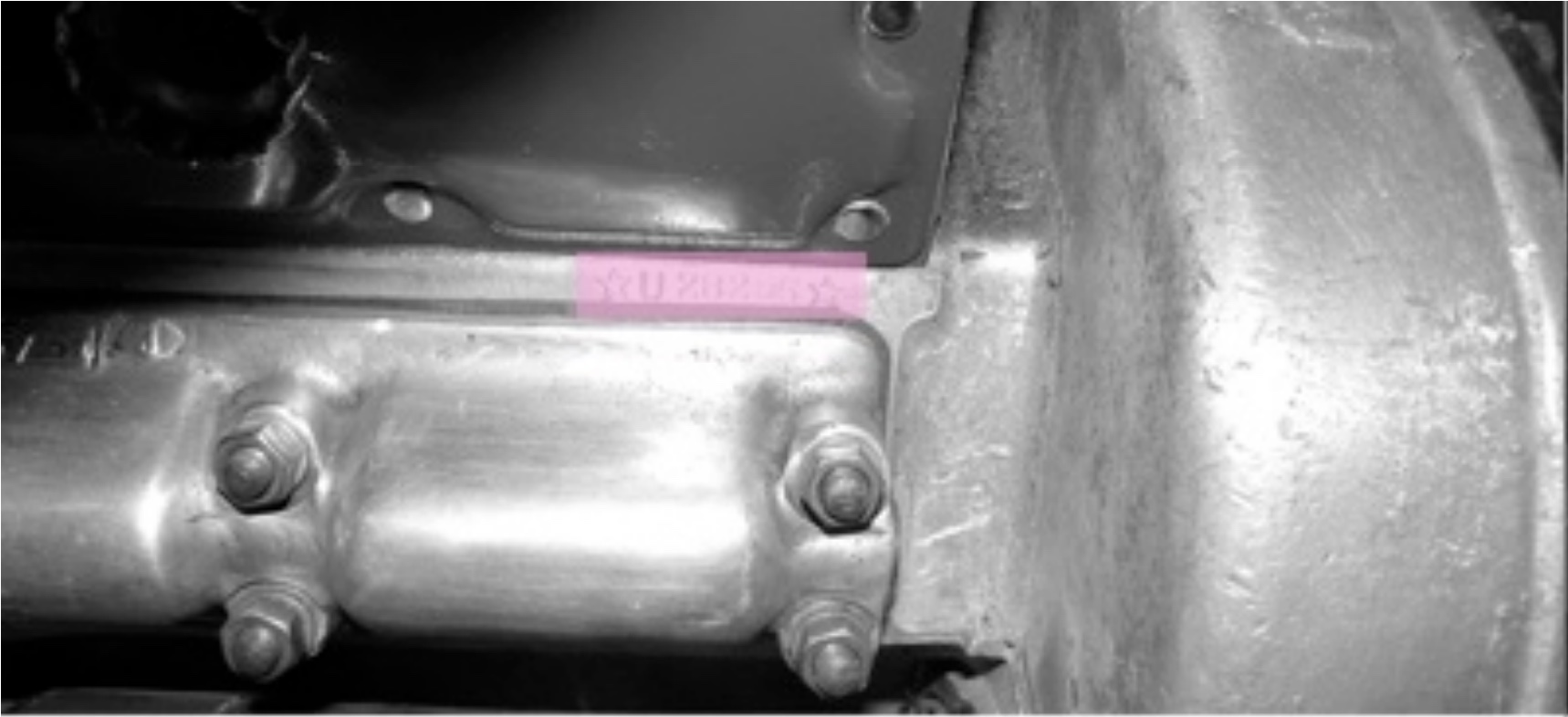 |
|
Disclaimer: The information compiled here was referenced from a variety of sources which included printed Packard Reference Books, original Packard materials, and information from Private Collections. That being said, we are all human, and that's why keyboards have delete and backspace buttons. So, mistakes happen. If any information is found to be in error, please let us know and we will correct the information if it is indeed found to be incorrect. This information should not be taken as gospel and should be verified before using in anyway. PackardInfo.com makes no warranties to it's correctness
|
Search
Recent Photos
Photo of the Day
Recent Registry
|


















